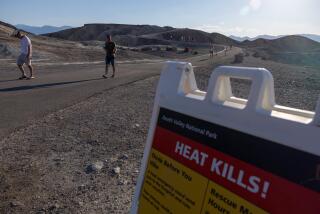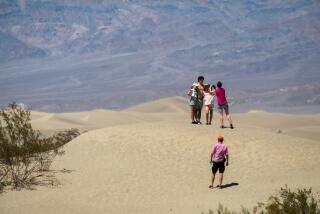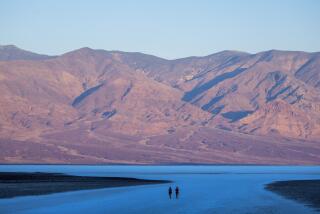It Took a Mule Team to Make a Park
It seems almost a contradiction in terms, particularly when you hike out to the old Harmony Borax Works--a rock salt landscape as tortured as you’ll ever find.
A park?
Surely if the notion of a park was ever mentioned to one of the rough drivers of the 20-mule-team borax wagons that crossed Death Valley, the response would be unprintable in a family newspaper.
Yet a park it now is. After years of acrimonious debate, the 1994 U.S. Congress passed the California Desert Protection Act that set aside millions of acres of desert in wilderness area and “upgraded” two national monuments--Joshua Tree and Death Valley--into national parks.
But back to borax. In Death Valley, strangely enough, the borax story and the park story are almost inseparable. Borax super-salesman Stephen T. Mather became the first director of the national park service in 1916.
“White gold,” Death Valley prospectors called it--not exactly a glamorous substance but a profitable one. From 1881 to 1887, more than 20 million pounds of borax were transported from the Harmony Borax Works.
Transport of the borax was the stuff of legends, too. The famous 20-mule teams hauled the huge loaded wagons 165 miles to the rail station at Mojave.
Down-on-his-luck prospector Aaron Winters first discovered borax on the salt flats in Furnace Creek in 1881. He was ecstatic when San Francisco investor William Coleman purchased his rights to the borax field for $20,000. Coleman capitalized construction of the Harmony Borax Works, an endeavor that depended first and foremost on the Chinese laborers who gathered the fibrous clusters of borate called “cotton balls.”
After purification at the borax works, the substance was loaded into custom 15-foot-long wagons to be hauled by 10 pairs of mules. The animals were controlled by a long jerk line and legendary mule-skinner profanity.
To learn more about this colorful era, visit the Borax Museum at Furnace Creek Ranch and the park visitor center, also located in Furnace Creek.
Directions: Reach Harmony Borax Works from Furnace Creek by following California 190 for 1 1/2 miles to the signed turnoff on the west side of the highway.
Trail head: A short trail with interpretive signs leads past the ruins of the old borax refinery and some outlying buildings.
The main trail leads 1.3 miles over the salt flats.
You’ll travel through a wash to the trail’s end at a wood post. From here it’s less than 200 yards to the edge of the salt marsh where borax was mined.
Adventurous hikers can make the trail-less trek across sometimes spongy terrain to the borax haystacks, two-foot-high piles of sodium calcium borate balls stacked here in the 1880s by Chinese laborers to prove claim assessment work.
The hike--and the photo opportunities--are particularly good early in the morning.
Harmony Borax Works Trail Where: Furance Creek, Death Valley National Monument Distance: 2.6 miles round trip; to H;aystacks is 5 miles round trip. Terrain: Salt flats, the odd “haystacks.” Highlights: Colorful walk into Death Valley history. Degree of Difficulty: Easy walk through Borax& , moderate walk to Haystacks. For More Information: Death Valley National Monument, Death Valley, Calif., 92328; tel. (619) 786-2331.
More to Read
Sign up for The Wild
We’ll help you find the best places to hike, bike and run, as well as the perfect silent spots for meditation and yoga.
You may occasionally receive promotional content from the Los Angeles Times.






